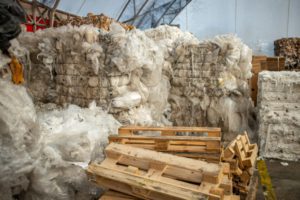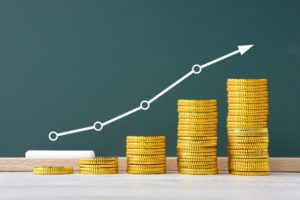We may be having a moment in plastic recycling.
Three big things = a moment.
McKinsey and a Key Missing Link to Plastics Circularity
For years, one of our nation’s preeminent consulting firms has been looking closely at how to jumpstart a circular economy for plastics, i.e., the widespread practice of reusing rather than discarding plastics.
On Monday, November 14, the firm published an article (“Beyond the Bottle: Solutions for Recycling Challenging Plastics”) about new opportunities to fill in the missing link in the plastics recycling chain. McKinsey examines the question:
So we can collect a lot of plastic, but can we sort it so recyclers can use it?
McKinsey says “Yes” because market forces and technology are aligning.
Historically, the quality of some plastics collected in curbside programs just simply hasn’t met the requirements of recyclers. Communities collected it, but recyclers couldn’t use it. This has resulted in used plastics going to landfills instead of being reused to make new products. This has been the case particularly for difficult-to-recycle used plastics like films, multi-layered packaging, tubes, and foam.
At the same time, consumer product companies/brands have been demanding a lot more recycled plastics than recyclers could produce.
To fix this disconnect – to make a more circular system work – we need to:
- Collect even more plastics than we’re collecting now to meet demand;
- Sort the material so recyclers can use it to make new products: and
- Do this on a scale large enough to drive down costs.
The missing link is bullet number two: sortation. McKinsey outlines the opportunity to create secondary sorting facilities they call “FPFs” (feedstock preparation facilities) that can “aggregate and upgrade” used plastics to increase their quality for recyclers.
Closing this missing link would seriously spur growth in the types and amounts of plastic recycled.
McKinsey’s key conclusion:
“Our conclusion is that demand for recycled plastics is strong, there are large volumes of untapped feedstock available to meet this demand, and… recycled material makes the economics attractive for the entire value chain to invest to collect and process this material to produce high-quality circular plastics.”
Yaas! In other words, there is huge demand for recycled plastics, and creating FPFs can help meet this demand through value chain investments for recycled plastics.
Read the McKinsey article here that describes how this can roll out.
Sortation Know-How Confirmed

But… can we really sort this stuff?
The answer: The data show, yes we can.
A recent sortation project in the Northeast gathered materials left over from recycling facilities, the stuff collected from households that typically gets landfilled because it’s too hard to sort. But… that’s exactly what this new facility did: sorted these leftovers. The process was able to capture 50% of these leftovers – and much of it is high quality plastics that now can be recycled.
This is a great example of McKinsey’s FPF, feedstock preparation facilities. Now this plastic, previously destined for landfills, is a valuable commodity, a feedstock material that can be remade into new plastics. Reducing the need for fossil resources and keeping more plastics out of landfills and our environment.
The idea of secondary sortation is not new. It was demonstrated years ago at a facility in the Northwest. What is new is the convergence of multiple forces, particularly economic, that can trigger the proliferation of these FPFs across the country.
Now all we need is investment…
America’s Plastic Makers (and Others) Are Investing
Note the phrase above in McKinsey’s key conclusion: “make the economics attractive for the entire value chain to invest.”
Well, two of the world’s largest plastic makers recently announced an agreement for just such an investment. At a whopping $100 million.
ExxonMobil and LyondellBasell are partnering with Cyclyx to build a massive sorting and processing facility – a key missing link – in the Houston area. Cyclyx says:
“The new facility addresses a critical missing link in the plastic waste supply chain by connecting community recycling programs to new and more advanced recycling technologies that have the potential to take a much wider variety of plastic materials.”
The project is designed to create a large, reliable source of used plastics for both traditional and advanced recyclers. E.g., advanced recyclers like ExxonMobil and LyondellBasell, which have committed to making increasing amounts of recycled plastics to meet growing demand from companies across the globe.
This facility will aggregate used plastics, improve its quality, and do so at scale to drive down costs. Pretty much what McKinsey said is needed to ratchet up plastics recycling.

In a second major investment, Waste Management and Dow just announced that they’re teaming up to allow communities to recycle plastic film at curbside, instead of store drop off. Curbside recycling could dramatically increase participation in recycling of plastic film, one of the fastest growing uses of plastics. As McKinsey notes: “This plastic could serve as feedstock for recyclers but today remains largely untapped.”
The program will begin in a Chicago suburb of 3,500 households and expand to multiple cities, eventually projected to reach more than 8% of U.S. households. At full capacity in 2025, it’s estimated to collect more than 265 million pounds of plastic each year to be made into new products. I suspect this type of collection will become the wave of the future for plastic film recycling.
BTW: Waste Management says it “expects to invest over $800 million through 2025 to improve and enhance recycling infrastructure, including specialized technology that will allow WM to sort plastic films.”
Dow. Waste Management. ExxonMobil. Lyondell Bassell. These are big companies investing big time in new ways to collect and sort plastics. They’re going all in on closing the missing link in plastics recycling.
Live in this Moment
This feels like a transformative moment in plastics recycling. The stars are aligning – supply, demand, technology, and investment – and we can see a clearer path forward to achieving our goal of reusing, recycling or recovering 100% of plastic packaging by 2040.
As Ferris Bueller said, “Life moves pretty fast. If you don’t stop and look around once in a while, you could miss it.”
I don’t stop and look around as much as I should. This time I am. And I’m enjoying the moment.

